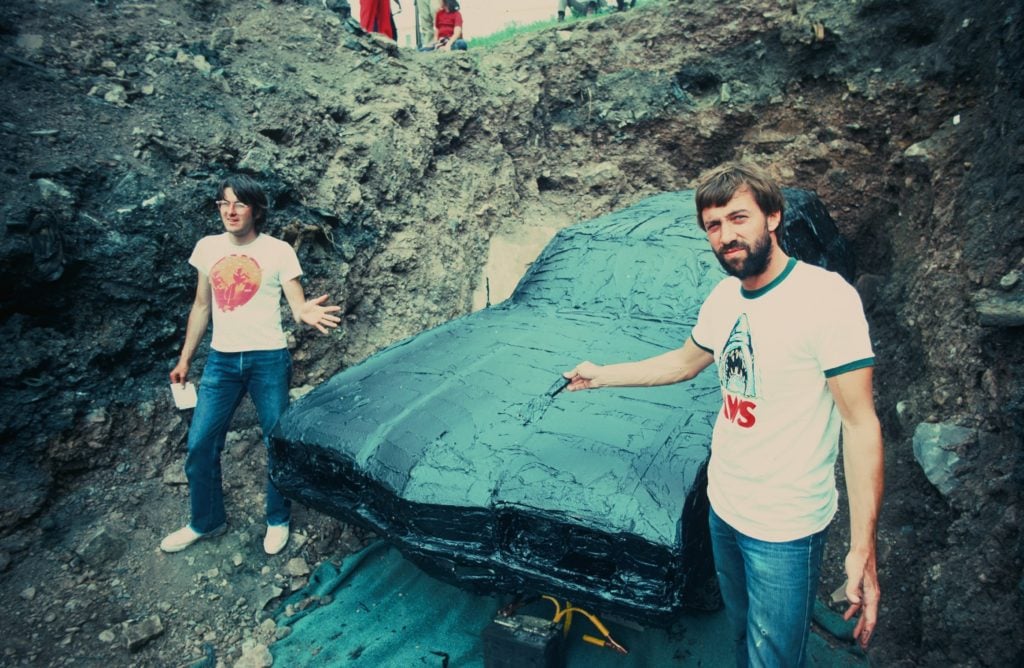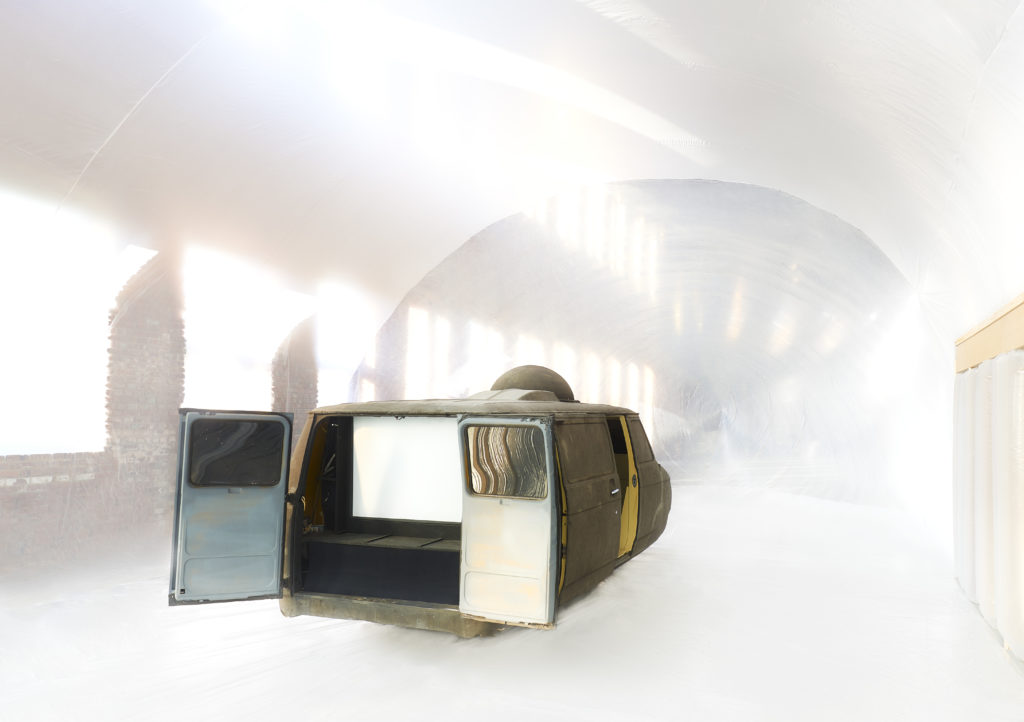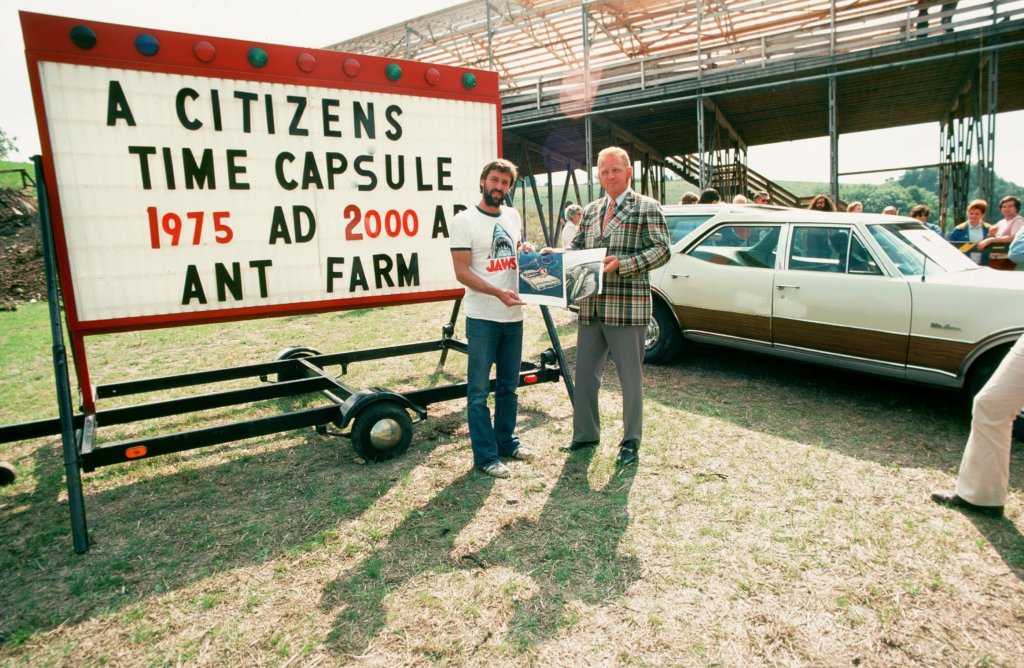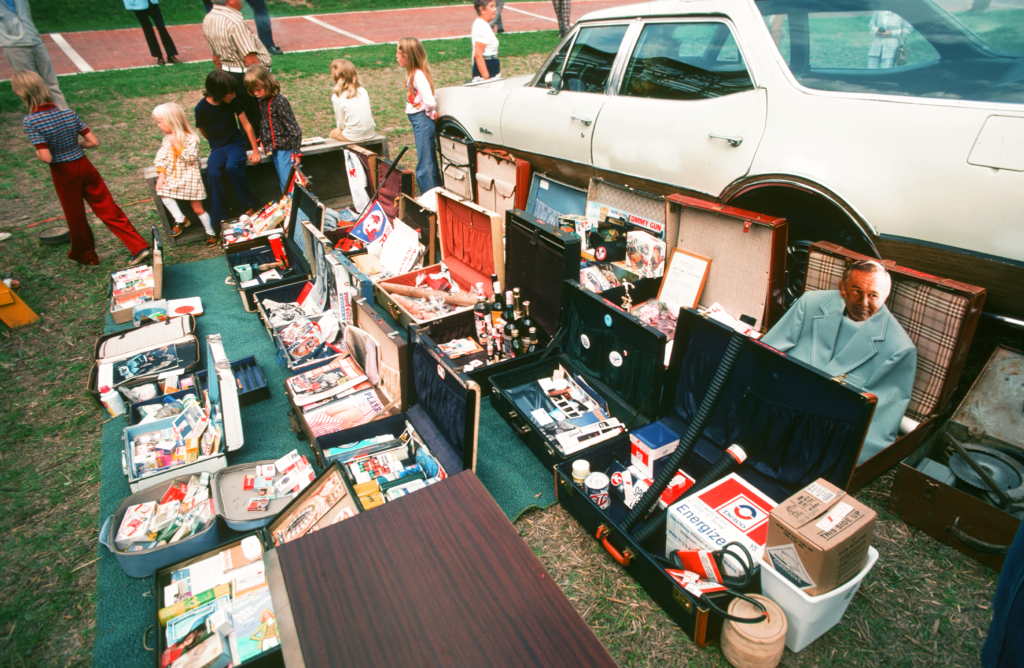On View
Can Members of Ant Farm Recover Its ‘Citizens Time Capsule,’ Buried for 40 Years?
A new exhibition points to Ant Farm's present incarnation and its hidden past.

A new exhibition points to Ant Farm's present incarnation and its hidden past.

Laura van Straaten

Premiering at the nonprofit Brooklyn artspace Pioneer Works is a compelling new tribute to the storied 1970s art collective Ant Farm and recent work by its offshoot, known as LST.
The exhibition, on view through October 23, showcases a series of so-called “failed” time capsules dating back to 1969: each was flooded, burned, looted and, in one case, not allowed to be unearthed as planned—although as artnet News learned, that one may yet be recoverable.
Ant Farm was part of a 1970s art movement that extended from America to England and Italy that Ken Johnson of The New York Times described as drawing variously “on Dada, Pop Art, hippie culture, science fiction and utopian traditions in the interest of shaking up, if not totally razing, established architectural theories and practices.” Ant Farm’s idol was Buckminster Fuller, whom the collective actually kidnapped for a day in 1969.
Ant Farm co-founder Doug Michels died in 2003. Four years later, its remaining members Chip Lord and Curtis Schreier—today in their 70s—joined forces with Bruce Tomb, about ten years their junior, to form LST (whose moniker is formed from the first letter of each surname). All were trained as architects.
The current exhibition at Pioneer Workhttps://www.theguardian.com/artanddesign/2016/sep/16/colombia-farc-female-fighters-in-picturess is titled “The Present is the Form of All Life: The Time Capsules of Ant Farm and LST,” but like the time capsules themselves, which play on visions of the future and projections of nostalgia, the show warps time. Even with new work by LST, the exhibition feels like a retrospective of Ant Farm, which the collective has surprisingly never mounted in the media capital of the world, despite Ant Farm’s historically important uses and critiques of media culture. And without the smart way that the exhibit’s co-curators Liz Flyntz and Gabe Florenz have wrapped Ant Farm’s history into the presentation, LST’s recent work would suffer from a lack of context and meaning.

Installation view. ‘The Present Is the Form of All Life: The Time Capsules of Ant Farm and LST.’ Curated by Liz Flyntz and Gabriel Florenz. Pioneer Works, New York, September 09–October 23, 2016. © Andrew Romer.
Ant Farm’s seminal pieces are still taught in art schools and serve as artistic reference points the world over. Take, for example, Cadillac Ranch (1974), in which the collective created a subversive “monument” to America and its car culture by half-burying a bunch of Cadillacs, or Media Burn (acquired by MoMA), in which they drove a car through a wall of burning TVs in part to protest what Schreier recalled in an interview as the “megalopoly” of the United States’ then-three TV networks.
The curators framed the exhibit to put past and present in conversation. Ant Farm made four time capsules between 1969 and 1975, which are documented in the exhibition alongside LST’s contemporary work known as Media Van, which is being shown for the first time in New York and will be for many visitors the highlight of Pioneer Works’ exhibition. It offers a chance to contribute to a digital version of what had been a uniquely analog endeavor to preserve human experience.
LST’s Media Van reimagines Ant Farm’s 1971 work of the same name, which was a Chevy van kitted-out like a nomadic TV studio. The current version is cocooned inside LST’s new, site-specific “inflatable”—like the ones for which Ant Farm is known. To enter the inflatable, you remove your shoes and push yourself (one person at a time) through an also-inflated doorway that Schreier nicknamed “hot lips” or “the birth canal.” This inflatable is made of clear plastic, and it’s shaped like an enormous avec serif comma. Imagine a bounce-less birthday-party bouncy house that is 105 feet long, more than 27,000 cubic feet, and almost hermetically sealed.
Media Van is also a Chevy van painted with black roofing tar that resembles encrusted dirt. This version has both a fake “documented” backstory of its discovery in a United States missile silo by LST and a fake future feigning that the van will depart Pioneer Works to be buried until 2030.

Installation view. ‘The Present Is the Form of All Life: The Time Capsules of Ant Farm and LST.’ Curated by Liz Flyntz and Gabriel Florenz. Pioneer Works, New York, September 09–October 23, 2016. © Andrew Romer.
Visitors enter the van though its sliding side door to find it gutted and re-configured around a curious time capsule-creating apparatus LST calls “the HUQQUH” (deliberately pronounced “hookah”). “It’s a palindrome which nicely addresses the forward and backwards aspects of a time capsule,” LST’s Tomb explained. Visitors are invited to plug their digital devices into the HUQQUH, which randomly chooses a photo from the device. “The idea is would be a more objective selection of what’s out there,” said Lord, rather than a carefully edited selection of chosen images. Each time the HUQQUH chooses an image for the time capsule, it spits out an ATM-style receipt. On opening night, a trio of young architects donated images of dumplings, a project site, and a photo taken at the Farnsworth House.
The exhibition includes beautiful and often fantastical drawings, sketches, graphs and other media documenting the iterative conception of Media Van, technically named Ant Farm Media Van v.08 [Time Capsule]. Various iterations of Media Van have also been exhibited before, including most recently at the Hippie Modernism exhibit at the Walker Art Center
Chip Lord, speaking on a panel with his fellow LST members, said that in conceiving the HUQQUH and how it would function, “We talked a lot about what a time capsule should be in the 21st century and we realized it should be very different than what it was in the 20th.” Referring to his mobile phone, Bruce Tomb said that as artists they had to ask themselves, “What could we do with this project that would be any different or better than what we have in our pocket?”
Relatedly, co-curator Gabe Florenz writes that current new time capsule only operates with what he calls “apprehensive consent” from participants: “We’re so comfortable now with giving up personal information and media to the web–constantly uploading pictures to Facebook, etc., as a means of curating our online persona–yet with the HUQQUH we’re relinquishing control, letting a device arbitrarily decide for us what’s preserved for the future.”
Media Van builds on Ant Farm’s storied Citizens Time Capsule (1975), which is referred to in the Pioneer Works’ exhibition as one of the time capsule “failures.” But new reporting suggests that all may not be lost.
Citizens Time Capsule was created by placing a newspaper ad inviting contributions from the community. The handwritten logs of what was contributed by whom and why are on view at Pioneer Works. The logs make for entertaining reading: children’s toys, personal memorabilia, magazines of the day, marijuana, a can of Pringle’s potato chips (new at the time), and hundreds of other items. Schreier described the process: citizens donated items that were put into second-hand suitcases for display at a well-attended public performance event in Lewiston, NY. The event was held at the storied Artpark, which originated as a mecca for land art works in honor of Robert Smithson. Until Artpark shifted its focus to being a concert venue, more than 200 artists and collectives created art and installations over the course of a decade.

Ant Farm. Citizens Time Capsule, 1975. Doug Michels posing with Oldsmobile Vista Cruiser salesman, holding a 1968 brochure of the Oldsmobile Vista Cruiser station wagon, Lewiston, New York. 35mm slide. Courtesy Chip Lord.
To bury Citizens Time Capsule, the suitcases were wrapped in plastic and packed into a 1968 Oldsmobile Vista Cruiser station wagon, which was itself wrapped in plastic and buried on the Artpark land. All parties agree that Citizens Time Capsule was to be disinterred 25 years later, in 2000. But Artpark was found to have been built on contaminated soil, and the soil was later declared an environmental hazard. As a result, The New York State Parks department, which oversees the land, has not permitted the artwork to be removed, citing environmental concerns. A Parks spokesperson declined to comment or explain what conditions and protocols would be needed to allow the removal of the artwork.
“Doug Michels spent a lot of energy trying to get people interested in excavating it,” said Chip Lord. Some of that correspondence is on view at Pioneer Works. But Lord encouraged evenhandedness: “It doesn’t do anybody any good to be angry about it.”
Many people would like to see Citizens Time Capsule unearthed, as the artists and its citizen contributors planned. Flyntz, the co-curator of the Pioneer Works show, trekked to Artpark on her own to investigate. Using old photos and natural landmarks, she was able to locate where the time capsule is buried. “It is still there lying in an unmarked grave,” she said.
Longtime Artpark employee Tanis Winslow, who now heads its visual arts program, would also love to see Ant Farm’s time capsule excavated. She recalled an early attempt to do so, before State Parks employees shut down the effort after a few shovels of earth revealed what she said was sulfur in the ground below. “It isn’t just a matter of pulling it out, it is a matter of following protocol, and making sure soil was tested and everything is done in a really environmentally conscious way,” Winslow said.
Michael J. Beam, the curator of exhibitions and collections at The Castellani Art Museum of Niagara University, also longs to see Citizens Time Capsule unburied. “What has been lost–what is in limbo here–is this interesting cultural history.” The project to unearth the time capsule was on his desk when he joined the museum 13 years ago. “Usually when I get my teeth into something I don’t give up on it, but this just didn’t move forward, which is really sad.” He said his museum, located less than two miles from Artpark, continues to stand behind its 2003 offer of assistance with inventory, curation, and exhibition space, should Citizens Time Capsule one day be unearthed. “I just want to see this come out of the ground, he said, ”I just want to help facilitate that happening.”
What dogs him is the feeling that Citizens Time Capsule hasn’t come full circle. “The piece is unfinished. The second half is bringing it out,” Beam said, “It is a shame and is a disservice to the community that participated and donated their time and artifacts that it has not been done.” He noted that some preliminary fundraising inquiries about a possible future excavation and exhibition had proved promising, adding that “it wouldn’t just be a regional exhibit but also a national story because of Artpark and Ant Farm’s incredible history.”
Tony Bannon was an artist in residence at Artpark the same year as Ant Farm, in 1975, and he now serves as director of SUNY Buffalo’s Burchfield Penney Art Center, which houses Artpark’s archives. Bannon knew the Ant Farm crew and participated in the burial of the Citizens Time Capsule.
Bannon lamented that the time capsule has not been unearthed but stressed that it is not about what’s been buried. “I don’t care about what’s in the car. It has nothing to do with the car, the objects.” He recalled that he added a 4×6-inch photo of Mao Tse-Tung to be buried.

Ant Farm. Citizens Time Capsule, 1975. Suitcases filled with donations for time capsule, Lewiston, New York. 35mm slide. Courtesy Chip Lord.
Bannon’s dream has been that that if Citizens Time Capsule were unearthed, there would be a “ceremony” for all the artists and the citizen contributors who participated. “And it would be a magnet to bring us back,” he said.
“I would hope that Artpark, if they ever came to do it, would seek us all out for a discourse on ‘Where did you succeed’ and ‘Where did you fail?’” He paused for a moment, as if thinking back to a bygone era. “What’s been thwarted is the opportunity for us to come back and share what we have learned in the interim, especially about culture as practice and many of the ideas about art and society that many of us were there chasing.”
The spirited Schreier addressed the topic from the stage at Pioneer Works’ panel discussion with his fellow LST colleagues. “If I have anything to do with the Artpark time capsule,” he said, “it will probably be more like an archaeologist more than a mad participant. And I expect some very, very hot things to come down in the future with this particular project,” he added, with a determined look that at first drew laughter and then applause from the audience, who may have been thinking of the past, present, and possible all at once.